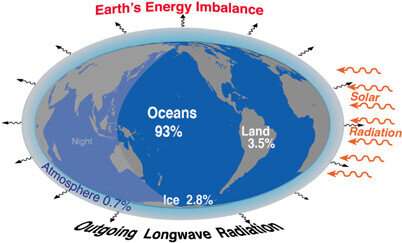Characterizing climate change from heating, not merely temperature

Current human–induced climate change arises primarily from the heating of the planet from changes in atmospheric composition. Only one manifestation of this is temperature change. Yet the focus of many media reports is on temperatures and whether the Paris Agreement targets of 1.5°C or 2°C have been breached or threatened. A new paper published in the Journal of Climate Action, Research, and Policy challenges this framing.
The increasing amount of greenhouse gases (notably carbon dioxide from burning fossil fuels) in the atmosphere leads to Earth's Energy Imbalance (EEI) and altered flows of energy through the climate system.
The dissemination of excess energy is partly what determines how climate change is manifested. Some of the extremes being experienced—especially those involving drought, convection, storms, flooding, and the water cycle—are mostly driven by aspects of heating. While temperature contributes through the water–holding capacity of the atmosphere, it is more a consequence than a cause.
After all, water is the air–conditioner of the planet. Natural climate variability—such as the strong El Niño currently underway—generally determines where new extremes occur and can lead to confusion as to what is going on. Human–caused change exacerbates the weather and natural variability.
The United Nations—and especially the Intergovernmental Panel on Climate Change (IPCC) in their Summary for Policy Makers—focus on global temperature targets rather than broader facets of climate change, including EEI, and do not always adequately discriminate between temperature and heating.
This also has consequences for future climate control if or when heating is brought under control by cutting emissions. Improvements are needed in expressing how the climate is changing by properly accounting for the flow of energy through the climate system.
The new climate norm has a warmer ocean and less ice, and some changes on the warmer land mean less and maybe destabilized permafrost. Rainfall's character changes substantially. Many changes do not relate directly to global temperature but are nonetheless physically related to the heating climate.
The new paper is authored by Kevin Trenberth, who has watched as climate change (global warming) was ignored, then dismissed, underreported, largely missing in many disaster reports where it should have been included, to now being blamed for almost everything.
He emphasizes that increased heating often leads to more evaporation from the ocean and terrestrial surfaces. The resulting increased amount of atmospheric water vapor causes more intense storms and heavier rains, raising the risk of flooding.
More information:
Kevin E. Trenberth, Characterizing Climate Change from Heating, Not Merely Temperature, Journal of Climate Action, Research, and Policy (2024). DOI: 10.1142/S2972312424750018
Provided by World Scientific Publishing